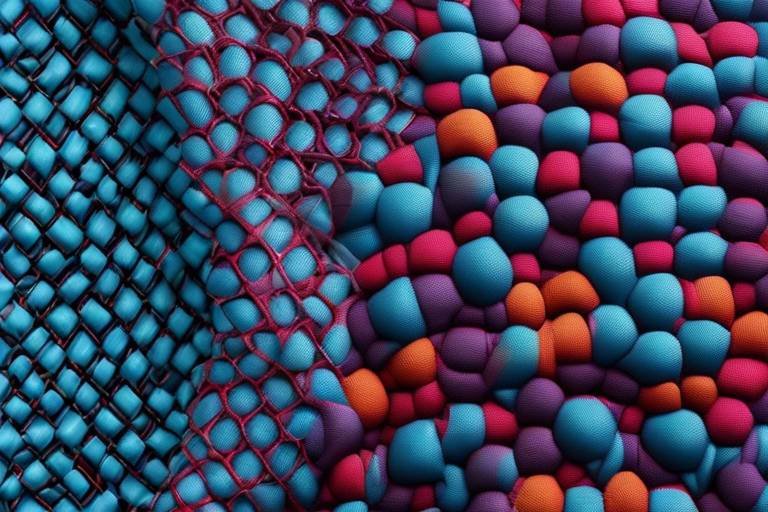The Science Behind Biodegradable Materials and Technology
In a world increasingly concerned about the environmental impact of waste, the quest for sustainable solutions has never been more urgent. Biodegradable materials emerge as a beacon of hope, paving the way for a cleaner, greener future. But what exactly are these materials, and how do they work? This article dives deep into the principles of biodegradable substances, examining their significance, the science behind their decomposition, and the latest technological advancements that promise to revolutionize our approach to waste management.
At its core, biodegradable materials are designed to break down naturally through the action of microorganisms. Unlike conventional plastics that can linger in landfills for centuries, biodegradable options can decompose into natural substances like water, carbon dioxide, and biomass in a relatively short period. This transformation is not just a matter of convenience; it significantly reduces the burden of waste on our environment. The types of biodegradable materials include:
- Natural Polymers: Derived from renewable resources such as corn starch and cellulose.
- Bioplastics: Made from biological substances rather than petroleum.
- Compostable Materials: Specifically designed to decompose in composting conditions.
Understanding these materials is crucial for recognizing their potential in mitigating environmental pollution. As we become more aware of the damage caused by plastic waste, the significance of biodegradable materials grows exponentially.
Now, let's delve into the fascinating world of chemistry that makes biodegradation possible. The process involves complex chemical reactions that transform solid waste into simpler, non-toxic substances. When biodegradable materials are exposed to the right conditions, they undergo a series of reactions facilitated by microorganisms. These reactions can be influenced by several factors, including:
- Temperature: Higher temperatures can accelerate microbial activity.
- Moisture: Adequate moisture is essential for microbial survival and activity.
- pH Levels: The acidity or alkalinity of the environment can affect the efficiency of biodegradation.
Understanding these elements is vital for optimizing the biodegradation process, ensuring that materials decompose efficiently and effectively.
Microorganisms are the unsung heroes of the biodegradation process. These tiny life forms, including bacteria and fungi, play a crucial role in breaking down biodegradable materials. Each type of microorganism has its unique function, contributing to the overall process of decomposition. For instance, some bacteria specialize in breaking down complex organic compounds, while fungi are adept at decomposing tougher materials like lignin found in wood.
Fungi and bacteria are the primary agents of biodegradation. Fungi, with their extensive network of hyphae, can penetrate and break down organic matter effectively. Bacteria, on the other hand, are incredibly diverse and can thrive in various environmental conditions, making them essential for decomposing a wide range of materials. Their unique properties allow them to work in tandem, accelerating the breakdown of biodegradable substances.
The efficiency of biodegradation is not solely dependent on the microorganisms themselves; environmental conditions play a pivotal role. Factors such as temperature, moisture, and pH significantly influence microbial activity. For example, a warm, moist environment fosters rapid decomposition, while extreme cold or dryness can slow down the process. Understanding these conditions allows us to create optimal environments for biodegradation, enhancing the effectiveness of biodegradable materials.
Assessing the biodegradability of materials is essential for environmental compliance and consumer safety. Various testing methods are employed to evaluate how quickly and completely materials decompose. Common methods include:
- ASTM D6400: A standard specification for compostable plastics.
- ISO 14855: A test method for determining aerobic biodegradation in controlled composting conditions.
- OECD 301: A series of tests for assessing the biodegradability of chemicals.
These assessments ensure that biodegradable products meet regulatory standards and truly contribute to reducing environmental impact.
Biodegradable materials are making waves across various industries, from packaging to agriculture and consumer products. Their versatility and eco-friendliness provide a compelling alternative to traditional materials. In packaging, for instance, biodegradable solutions are increasingly being adopted to reduce waste and promote sustainability. Think about it: a world where your food packaging decomposes rather than pollutes our planet. That’s a future worth striving for!
The packaging industry is rapidly embracing biodegradable materials, leading to innovative solutions that minimize waste. These materials not only reduce the environmental footprint but also appeal to eco-conscious consumers. Companies are now developing packaging made from plant-based polymers, which can decompose in composting facilities, creating a circular economy.
Compostable products are designed to break down in composting conditions, offering a practical solution for waste management. These items, from disposable cutlery to shopping bags, contribute to a more sustainable waste management strategy. By composting these products, we can return valuable nutrients to the soil, closing the loop in our consumption cycle.
As we look ahead, advancements in biodegradable technology are promising exciting developments. Researchers are exploring new materials and methods to enhance the biodegradability of products, making them even more efficient and effective. Emerging trends include the use of nanotechnology to create biodegradable composites and the development of biopolymers from agricultural waste. The potential for innovation is vast, and as technology evolves, so too will our ability to combat waste and pollution.
1. What are biodegradable materials?
Biodegradable materials are substances that can be broken down by microorganisms into natural elements like water and carbon dioxide, significantly reducing their environmental impact.
2. How long does it take for biodegradable materials to decompose?
The time required for biodegradation varies based on the material and environmental conditions, ranging from a few weeks to several months.
3. Are biodegradable materials always compostable?
Not all biodegradable materials are compostable. Compostable materials require specific conditions to decompose, while biodegradable materials can break down under a wider range of conditions.
4. How can I ensure I’m using biodegradable products?
Look for certifications like ASTM D6400 or ISO 14855 on products, which indicate that they meet specific standards for biodegradability.

Understanding Biodegradable Materials
Biodegradable materials are a fascinating and essential aspect of our journey towards a more sustainable future. In simple terms, these materials are capable of breaking down naturally through the action of microorganisms, such as bacteria and fungi. This natural decomposition process is vital, as it helps reduce the accumulation of waste in landfills and minimizes environmental pollution. Imagine walking through a park and not seeing plastic bottles strewn everywhere; that's the kind of world biodegradable materials can help create!
There are several types of biodegradable materials, and they can be categorized based on their origin and composition. Some of the most common types include:
- Natural Biodegradable Materials: These are derived from natural sources, such as plants and animals. Examples include paper, cotton, and food waste.
- Synthetic Biodegradable Materials: These are man-made materials designed to decompose under specific conditions. They often include biodegradable plastics made from corn starch or other renewable resources.
The significance of biodegradable materials cannot be overstated. As our planet grapples with the consequences of plastic pollution, the need for sustainable alternatives becomes increasingly urgent. Traditional plastics can take hundreds of years to decompose, leading to a buildup of waste that harms wildlife and disrupts ecosystems. In contrast, biodegradable materials can break down into harmless substances, such as water, carbon dioxide, and organic matter, within a much shorter timeframe.
Furthermore, using biodegradable materials can contribute to a circular economy, where products are designed with their end-of-life in mind. This approach not only reduces waste but also promotes resource efficiency. For instance, when biodegradable materials decompose, they can enrich the soil, providing nutrients for new plant growth. This cycle of renewal is akin to nature's own recycling program, where nothing goes to waste!
In summary, understanding biodegradable materials is crucial for anyone interested in sustainability. By choosing biodegradable options, we can significantly reduce our environmental footprint and move towards a greener, cleaner planet. The next time you reach for a product, consider whether it’s biodegradable; your choice could make a world of difference!

The Chemistry of Biodegradation
Biodegradation is a fascinating process that involves the breakdown of organic materials by living organisms, primarily through the action of microorganisms. At its core, the chemistry of biodegradation is a series of complex chemical reactions that transform materials into simpler substances. These reactions are essential for recycling nutrients back into the ecosystem and mitigating waste. But how does this process actually work? Let's dive deeper into the chemical mechanisms that enable biodegradation and the factors that influence these reactions.
When biodegradable materials are exposed to the right environmental conditions, microorganisms such as bacteria and fungi initiate the degradation process. These organisms release enzymes that catalyze the breakdown of polymers into monomers. This transformation is critical because it allows the microorganisms to utilize the resulting smaller molecules as energy sources. The primary types of reactions involved in biodegradation include hydrolysis, oxidation, and fermentation. Each of these reactions plays a unique role in the decomposition process:
- Hydrolysis: This is the first step in biodegradation, where water molecules are used to break down complex polymers into smaller units.
- Oxidation: In this step, microorganisms convert the smaller molecules into energy, often releasing carbon dioxide and water as byproducts.
- Fermentation: Under anaerobic conditions, some microorganisms can convert organic matter into simpler compounds, producing methane or organic acids.
However, the efficiency of these chemical reactions does not solely depend on the materials themselves; it is also influenced by various environmental conditions. Factors such as temperature, moisture, and pH play a crucial role in determining how quickly and effectively biodegradation occurs. For instance, higher temperatures can accelerate microbial activity, leading to faster breakdown of materials. Conversely, extreme pH levels can inhibit the growth of microorganisms, slowing down the process significantly.
To illustrate this point, let’s take a look at a table summarizing the optimal conditions for biodegradation:
| Factor | Optimal Range | Impact on Biodegradation |
|---|---|---|
| Temperature | 20-40°C | Increased microbial activity, faster breakdown |
| Moisture | 40-60% moisture content | Essential for microbial growth and enzymatic activity |
| pH | 6-8 | Optimal for most microorganisms, extreme pH can hinder growth |
Understanding the chemistry behind biodegradation not only sheds light on how materials break down but also highlights the importance of creating conditions that favor this process. As we continue to innovate in the field of biodegradable materials, recognizing these chemical principles will be essential in developing more efficient and sustainable solutions to combat plastic pollution.
Q1: What types of materials are biodegradable?
A1: Biodegradable materials include natural substances like food waste, paper, and certain plastics designed to decompose in the environment.
Q2: How long does it take for biodegradable materials to decompose?
A2: The time frame varies widely depending on the material and environmental conditions, ranging from a few weeks to several months or even years.
Q3: Are all biodegradable materials compostable?
A3: No, while all compostable materials are biodegradable, not all biodegradable materials are suitable for composting, as they may require specific conditions to break down.

Microorganisms in Biodegradation
When we think about the magic of nature's recycling system, microorganisms are the unsung heroes. These tiny organisms, which include bacteria, fungi, and other microbes, play a pivotal role in breaking down biodegradable materials. Imagine a bustling city where every resident has a specific job to do; that's how microorganisms function in the ecosystem. They work tirelessly to decompose organic matter, turning waste into valuable nutrients that enrich the soil.
Different types of microorganisms have unique functions in the biodegradation process. For instance, bacteria are particularly adept at breaking down simple organic compounds. They thrive in various environments and can rapidly multiply, making them essential for quick decomposition. On the other hand, fungi are the champions of breaking down more complex organic materials, such as cellulose and lignin found in plant matter. They release enzymes that break these substances into simpler compounds, which can then be consumed by bacteria.
But what exactly do these microorganisms need to do their job effectively? Several environmental factors influence their activity:
- Temperature: Most microorganisms thrive in warm conditions, typically between 20°C and 40°C (68°F to 104°F). Extreme temperatures can slow down their metabolic processes.
- Moisture: Water is essential for microbial activity. Too little moisture can hinder their ability to break down materials, while too much can lead to anaerobic conditions, which some microbes cannot tolerate.
- pH Levels: The acidity or alkalinity of the environment can significantly impact microbial activity. Most bacteria prefer a neutral pH, around 6.5 to 7.5, while fungi can tolerate a broader range.
By understanding the roles and requirements of these microorganisms, researchers can enhance biodegradation processes, leading to more efficient waste management solutions. For example, scientists are exploring ways to optimize conditions in composting systems to maximize the activity of beneficial microorganisms. This not only accelerates the breakdown of organic waste but also produces nutrient-rich compost that can be used to enrich soil.
In summary, microorganisms are essential players in the biodegradation game. They transform waste into resources, helping to maintain ecological balance. As we continue to innovate in biodegradable technology, keeping these tiny allies in mind will be crucial for developing sustainable practices that benefit both our planet and future generations.

Fungi and Bacteria
When it comes to the world of biodegradation, fungi and bacteria are the unsung heroes. These microorganisms are nature's recyclers, tirelessly breaking down organic materials and returning vital nutrients to the ecosystem. Imagine them as the cleanup crew of the natural world, working diligently to ensure that waste doesn’t pile up and disrupt our environment. They play a pivotal role in transforming materials that would otherwise linger in landfills for centuries into harmless substances.
Fungi, particularly, are fascinating organisms. They have a unique structure that allows them to penetrate and decompose complex organic compounds. For instance, the mycelium, which is the vegetative part of fungi, spreads out like a vast network, breaking down tough substances like lignin and cellulose found in wood. This ability makes fungi particularly effective in decomposing plant matter, contributing significantly to nutrient cycling. On the other hand, bacteria are incredibly diverse, with species adapted to thrive in various environments. They perform a wide range of functions in the biodegradation process, from breaking down simple sugars to metabolizing complex polymers.
Here’s a quick breakdown of how these microorganisms contribute to biodegradation:
- Fungi: Decompose complex organic materials, especially cellulose and lignin.
- Bacteria: Rapidly break down simpler organic compounds and can adapt to various environmental conditions.
What’s even more impressive is the synergy between fungi and bacteria. In many cases, fungi create an environment conducive for bacteria by breaking down tough materials first, allowing bacteria to take over and complete the decomposition process. This collaborative effort not only speeds up biodegradation but also enhances the efficiency of nutrient recycling in ecosystems.
Environmental conditions also play a crucial role in determining the effectiveness of these microorganisms. Factors such as moisture levels, temperature, and pH can significantly impact their activity. For example, fungi generally thrive in moist, slightly acidic environments, while bacteria may flourish in a broader range of conditions. Understanding these needs can help us create better strategies for waste management and composting, leveraging the natural capabilities of these microorganisms.
In summary, fungi and bacteria are essential players in the biodegradation process, each bringing unique strengths to the table. Their ability to break down organic materials not only helps in waste reduction but also promotes a healthier environment. By harnessing their power, we can move towards more sustainable practices that benefit both the planet and future generations.
- What are the main types of fungi involved in biodegradation?
Common types include white rot fungi and brown rot fungi, both of which have unique abilities to decompose different types of organic materials.
- How do bacteria contribute to the biodegradation process?
Bacteria break down organic matter into simpler compounds, which can then be utilized by plants or further decomposed by other microorganisms.
- Can all organic materials be biodegraded?
While many materials can be biodegraded, some synthetic materials may take significantly longer or may not break down at all without specific conditions.

Environmental Conditions
When it comes to the biodegradation of materials, play a pivotal role in determining how effectively and quickly these materials break down. Just like a plant needs the right amount of sunlight and water to thrive, biodegradable materials require specific conditions to decompose efficiently. There are several key factors that influence the biodegradation process, and understanding these can shed light on why some materials break down faster than others.
One of the most crucial factors is temperature. Microbial activity typically increases with higher temperatures, which can accelerate the decomposition process. For instance, composting systems often operate best at temperatures between 55°C to 65°C (131°F to 149°F), where microorganisms are most active. Conversely, in colder environments, the decomposition rate can significantly slow down, leading to longer-lasting waste.
Another important factor is moisture. Microorganisms, including bacteria and fungi, require water to thrive. Insufficient moisture can hinder their activity, while excessive moisture can create anaerobic conditions that are less favorable for biodegradation. The ideal moisture content for biodegradation usually falls between 40% and 60%. This balance is crucial for maintaining an active microbial community that can effectively break down organic materials.
pH levels also play a significant role in biodegradation. Most microorganisms prefer a neutral pH range of around 6 to 8. If the pH is too acidic or too alkaline, it can inhibit microbial activity, slowing down the degradation process. For example, highly acidic conditions can lead to the death of beneficial microbes, while highly alkaline conditions can disrupt their metabolic processes.
Lastly, the availability of nutrients is essential for microbial growth. Just as humans need a balanced diet to function optimally, microorganisms require a mix of carbon, nitrogen, and other nutrients to thrive. In many cases, biodegradable materials that are rich in carbon, such as plant-based materials, break down more rapidly in nutrient-rich environments.
To summarize, the biodegradation process is influenced by a combination of factors, including:
- Temperature: Higher temperatures generally enhance microbial activity.
- Moisture: An optimal moisture level is crucial for effective decomposition.
- pH Levels: A neutral pH range supports microbial health.
- Nutrient Availability: Adequate nutrients are necessary for microbial growth and activity.
Understanding these environmental conditions not only helps in the effective design of biodegradable materials but also guides waste management strategies. By optimizing these factors, we can enhance the biodegradation process, leading to a cleaner and more sustainable environment.
Q1: What is the ideal temperature for biodegradation?
A1: The ideal temperature for biodegradation typically ranges from 55°C to 65°C (131°F to 149°F), where microbial activity is at its peak.
Q2: How does moisture affect biodegradation?
A2: Moisture is crucial for microbial activity. The ideal moisture content for biodegradation is between 40% and 60%. Too little moisture can slow down the process, while too much can create unfavorable anaerobic conditions.
Q3: Why is pH important in biodegradation?
A3: Most microorganisms thrive in a neutral pH range of 6 to 8. Extreme pH levels can inhibit microbial activity and slow down the biodegradation process.
Q4: What nutrients do microorganisms need for biodegradation?
A4: Microorganisms require a mix of carbon, nitrogen, and other nutrients to grow and function effectively in the biodegradation process.

Measuring Biodegradability
When it comes to understanding how biodegradable materials contribute to a healthier planet, measuring their biodegradability is absolutely essential. But what does this really mean? In simple terms, biodegradability refers to the ability of a material to break down naturally into harmless substances through the action of microorganisms over time. However, the process is not as straightforward as it may seem. Various factors influence how quickly and completely a material decomposes, and that's where specific testing methods come into play.
There are several standardized methods used to assess biodegradability, each with its own set of criteria and environmental conditions. One common approach is the ASTM D5338 test, which simulates a controlled composting environment to evaluate how well a material breaks down. This method measures the amount of carbon dioxide released during the degradation process, providing a clear indication of microbial activity and material breakdown. Other methods, such as the ISO 14855, focus on aerobic conditions, which are essential for composting.
In addition to these laboratory tests, real-world conditions must also be considered. Factors such as temperature, moisture levels, and the presence of oxygen can significantly impact biodegradation rates. For instance, a material may decompose quickly in a hot, moist environment but take much longer in cooler, drier conditions. Therefore, understanding the context in which a biodegradable material will be used is crucial for accurate measurements.
| Testing Method | Conditions | Key Measurement |
|---|---|---|
| ASTM D5338 | Controlled composting | Carbon dioxide release |
| ISO 14855 | Aerobic conditions | Decomposition rate |
| OECD 301 | Aerobic aquatic | Biochemical oxygen demand |
Moreover, it’s important to note that not all biodegradable materials are created equal. Some may break down completely into non-toxic substances, while others might leave behind harmful residues. This is why comprehensive testing is vital—not just for compliance with environmental regulations, but for ensuring that we are truly making a positive impact on our planet. As consumers become more conscious of their choices, the demand for clear and reliable biodegradability assessments is growing. After all, who wouldn’t want to know that their eco-friendly products are genuinely contributing to a cleaner environment?
- What is biodegradability? Biodegradability is the ability of a material to break down naturally into harmless substances through the action of microorganisms.
- Why is measuring biodegradability important? Measuring biodegradability helps us understand how quickly a material will decompose, ensuring it does not contribute to environmental pollution.
- What factors influence biodegradation? Factors such as temperature, moisture, oxygen levels, and the type of material all play a role in how quickly biodegradation occurs.
- Are all biodegradable materials safe for the environment? Not necessarily. Some biodegradable materials can leave behind harmful residues, so thorough testing is essential.

Applications of Biodegradable Materials
Biodegradable materials are making waves across various industries, and their applications are as diverse as they are impactful. From packaging to agriculture, these materials are not just a trend; they represent a significant shift towards sustainability. Imagine walking into a grocery store and seeing your favorite snacks wrapped in biodegradable packaging that not only protects the product but also decomposes naturally after use. This is not just a dream—it's becoming a reality!
One of the most prominent applications of biodegradable materials can be found in the packaging industry. Traditional plastic packaging has long been a major contributor to environmental pollution, and the transition to biodegradable alternatives is a game-changer. These innovative solutions are designed to break down into natural substances, minimizing waste and reducing the burden on landfills. For instance, biodegradable films made from plant-based materials are now being utilized for food packaging, ensuring that the products remain fresh while being environmentally friendly.
In addition to packaging, biodegradable materials are increasingly used in agriculture. Farmers are adopting biodegradable mulch films that help control weeds, retain soil moisture, and improve crop yields. Once the growing season is over, these films decompose, enriching the soil rather than contributing to plastic pollution. This not only promotes a healthier ecosystem but also reduces the need for labor-intensive cleanup processes.
Another exciting area where biodegradable materials are making their mark is in consumer products. From utensils to plates made from cornstarch to biodegradable straws, the market is flooded with options that cater to environmentally conscious consumers. These products are not only functional but also offer a sense of responsibility towards the planet. By choosing biodegradable alternatives, consumers are taking a stand against single-use plastics and supporting a sustainable future.
Moreover, the medical industry is exploring biodegradable materials for applications such as sutures and drug delivery systems. These materials can dissolve in the body over time, eliminating the need for surgical removal and reducing the risk of infection. This innovative approach not only enhances patient care but also aligns with the growing demand for sustainable practices in healthcare.
In summary, the applications of biodegradable materials are vast and varied. As industries continue to innovate and embrace these sustainable alternatives, the positive impact on the environment becomes increasingly significant. The shift towards biodegradable materials is not just a trend; it is a necessary evolution in our quest for a cleaner, greener planet.
- What are biodegradable materials? Biodegradable materials are substances that can break down naturally through the action of microorganisms, returning to the environment without causing pollution.
- How long does it take for biodegradable materials to decompose? The decomposition time can vary widely depending on the material and environmental conditions, ranging from a few weeks to several months.
- Are biodegradable materials more expensive than traditional plastics? While they can be more costly to produce, the long-term environmental benefits often outweigh the initial investment.
- Can biodegradable materials be recycled? In some cases, yes, but it is important to check local recycling guidelines as not all biodegradable materials are suitable for traditional recycling processes.

Biodegradable Packaging Solutions
In recent years, the packaging industry has witnessed a remarkable shift towards sustainability, with leading the charge. As consumers become increasingly aware of the impact of plastic waste on our planet, businesses are stepping up to meet this demand by adopting materials that can naturally decompose over time. But what exactly does this mean for the environment and the future of packaging? Let's dive deeper into the world of biodegradable packaging.
Biodegradable packaging is made from materials that can be broken down by microorganisms into natural substances like water, carbon dioxide, and biomass. This process not only reduces the amount of waste that ends up in landfills but also minimizes the harmful effects of traditional plastic packaging, which can take hundreds of years to decompose. Some of the most commonly used biodegradable materials include:
- PLA (Polylactic Acid): Derived from renewable resources like corn starch, PLA is a popular choice for packaging due to its compostable properties.
- PHA (Polyhydroxyalkanoates): This is produced by bacteria through the fermentation of organic materials and is fully biodegradable.
- Paper and Cardboard: When sourced sustainably, these materials can be biodegradable and recyclable, making them an excellent alternative for packaging.
One of the most exciting aspects of biodegradable packaging is the innovation that is driving its development. Companies are exploring various materials and production methods to create packaging that not only meets the needs of consumers but also aligns with environmental goals. For instance, some brands are utilizing mushroom-based packaging, which is both biodegradable and compostable, offering a unique solution to plastic waste.
Moreover, the rise of biodegradable packaging has sparked a transformation in consumer behavior. More and more people are choosing products based on their packaging, often opting for those that are environmentally friendly. This shift is not merely a trend; it reflects a growing consciousness about sustainability and a desire to contribute to a healthier planet. As a result, brands that embrace biodegradable packaging can enhance their reputation and appeal to eco-conscious consumers.
However, the transition to biodegradable packaging is not without its challenges. One major concern is the infrastructure for composting and recycling these materials. While biodegradable packaging can break down in the right conditions, many facilities are not equipped to handle them properly. This highlights the need for improved waste management systems and consumer education on how to dispose of biodegradable products correctly.
In summary, biodegradable packaging solutions represent a significant advancement in the quest for sustainability. By choosing materials that break down naturally, we can reduce our environmental footprint and pave the way for a cleaner, greener future. As technology continues to evolve, the possibilities for innovative biodegradable packaging are endless, making it an exciting area to watch in the coming years.
- What is biodegradable packaging? Biodegradable packaging is made from materials that can be broken down by microorganisms into natural substances, reducing waste and environmental impact.
- How long does it take for biodegradable packaging to decompose? The decomposition time can vary based on the material and environmental conditions, but it typically ranges from a few months to a couple of years.
- Can biodegradable packaging be recycled? Some biodegradable materials can be recycled, but it's essential to check local guidelines, as not all facilities accept them.
- Is biodegradable packaging more expensive than traditional packaging? While the initial cost of biodegradable packaging can be higher, many companies find that it can lead to long-term savings and improved brand loyalty.

Compostable Products
Compostable products are more than just a trend; they represent a significant shift in how we approach waste management and environmental responsibility. Unlike traditional plastics, which can linger in landfills for centuries, compostable items are designed to break down into natural, organic matter when exposed to the right conditions. This means they not only reduce waste but also contribute to enriching the soil, making them a win-win for both consumers and the planet.
So, what exactly makes a product compostable? Generally, compostable items are made from natural materials such as plant starches, cellulose, or even certain types of bioplastics that can decompose under specific conditions. These products are engineered to break down within a certain timeframe, typically within 90 to 180 days, depending on the environmental factors and the composition of the material. This rapid decomposition process is crucial, as it helps to minimize the accumulation of waste in landfills and reduces greenhouse gas emissions associated with traditional waste disposal methods.
One of the most significant advantages of compostable products is their ability to return nutrients to the earth. When these items decompose, they create compost, a nutrient-rich organic material that can be used to enrich soil in gardens, farms, and landscaping projects. This not only helps in growing healthier plants but also promotes sustainable agricultural practices. The cycle of life continues as compostable products help to nourish the earth, making it a more vibrant and fertile place.
However, it's important to note that not all compostable products are created equal. Some require industrial composting facilities to break down effectively, while others can decompose in home composting systems. This distinction is crucial for consumers to understand, as it influences how they dispose of these products. To help navigate this landscape, here’s a quick comparison of different types of compostable products:
| Type of Compostable Product | Decomposition Conditions | Examples |
|---|---|---|
| Home Compostable | Can break down in home compost bins | Biodegradable plates, cups, and utensils |
| Industrial Compostable | Requires high temperatures and specific conditions to decompose | Some bioplastics and packaging materials |
| Compostable Food Waste | Breaks down in any composting environment | Fruit and vegetable scraps, coffee grounds |
As consumers become increasingly aware of their environmental footprint, the demand for compostable products continues to grow. Businesses are responding by innovating and expanding their product lines to include compostable options. From food service industries adopting compostable utensils to grocery stores offering compostable bags, the movement is gaining momentum. It’s a shift that not only reflects changing consumer preferences but also highlights a broader commitment to sustainability.
In conclusion, compostable products are paving the way for a more sustainable future. By choosing these items, individuals can play a part in reducing waste, enriching the earth, and supporting eco-friendly practices. As we continue to innovate and improve composting technologies, the potential for compostable products to make a significant impact on our environment grows ever stronger.
- What is the difference between biodegradable and compostable? Biodegradable products break down into smaller pieces over time, while compostable products decompose into nutrient-rich compost under specific conditions.
- Can I compost compostable products at home? Yes, many compostable products can be added to home compost bins, but it's essential to check the product specifications to ensure they are suitable for home composting.
- How long does it take for compostable products to decompose? Typically, compostable products break down within 90 to 180 days, depending on the conditions and the material used.
- Are compostable products more expensive than traditional products? While they can be slightly more expensive, the environmental benefits often outweigh the costs, especially as technology advances and production scales up.

The Future of Biodegradable Technology
The future of biodegradable technology is not just a distant dream; it’s unfolding right before our eyes. With the increasing awareness of environmental issues, researchers and innovators are racing to develop materials that can naturally break down without leaving a harmful footprint. Imagine a world where plastic packaging doesn't linger in landfills for centuries but instead decomposes within a matter of months! This vision is becoming a reality thanks to groundbreaking advancements in biodegradable materials.
One of the most exciting trends in this field is the development of bio-based plastics. Unlike traditional plastics derived from fossil fuels, these materials come from renewable resources like corn starch, sugarcane, and even waste products. This shift not only reduces our reliance on non-renewable resources but also decreases greenhouse gas emissions associated with plastic production. As technology advances, we can expect these bio-based plastics to become more affordable and widely adopted across various industries.
Another fascinating area of research is the enhancement of biodegradation rates. Scientists are exploring ways to engineer materials that break down faster and more efficiently. For instance, incorporating specific enzymes or microbes into the materials can significantly speed up the decomposition process. This means that products designed for single use, such as cutlery or packaging, could be gone in the blink of an eye, leaving no trace behind. The implications for waste management and environmental health are monumental.
Moreover, the integration of smart technology into biodegradable materials is on the horizon. Imagine packaging that can signal when it’s time to be disposed of or composted! This could be achieved through the use of biodegradable sensors that monitor environmental conditions. Such innovations could lead to more efficient recycling processes and a better understanding of how these materials interact with their surroundings.
As we look towards the future, it’s essential to consider the role of government policies and consumer behavior in shaping the market for biodegradable products. Regulations promoting sustainable practices and incentivizing the use of biodegradable materials can drive change at a large scale. Additionally, as consumers become more educated and demand eco-friendly products, companies will be pushed to innovate and adopt these technologies.
In summary, the future of biodegradable technology is bright and full of potential. With continuous research, innovative practices, and a shift in consumer attitudes, we are on the cusp of a major transformation in how we approach materials and waste. The possibilities are endless, and the benefits could be monumental for our planet. The journey towards sustainability is well underway, and biodegradable technology is leading the charge!
- What are biodegradable materials? Biodegradable materials are substances that can break down naturally through the action of microorganisms, reducing environmental pollution.
- How long does it take for biodegradable materials to decompose? The decomposition time varies based on the material and environmental conditions, but many biodegradable products can break down within months to a few years.
- Are biodegradable materials always environmentally friendly? While they are designed to reduce pollution, the overall environmental impact depends on how they are produced and disposed of.
- What is the difference between biodegradable and compostable? While all compostable materials are biodegradable, not all biodegradable materials are compostable. Compostable materials break down under specific composting conditions.
Frequently Asked Questions
- What are biodegradable materials?
Biodegradable materials are substances that can break down naturally through the action of microorganisms like bacteria and fungi. They decompose into natural elements, significantly reducing waste and pollution in the environment.
- How does the process of biodegradation work?
Biodegradation involves complex chemical reactions where microorganisms consume organic materials. These tiny agents break down the structure of the material, leading to its transformation into simpler compounds, often resulting in harmless byproducts like water and carbon dioxide.
- What types of microorganisms are involved in biodegradation?
Fungi and bacteria are the primary players in the biodegradation process. They each have unique properties that allow them to thrive in various environments and effectively break down different types of organic materials.
- What environmental conditions affect biodegradation?
Several factors influence the efficiency of biodegradation, including temperature, moisture, and pH levels. For instance, warmer temperatures and adequate moisture generally speed up the breakdown process, while extreme conditions can hinder microbial activity.
- How is biodegradability measured?
Assessing biodegradability involves various testing methods. These tests evaluate how quickly and completely a material decomposes under specific conditions, ensuring compliance with environmental standards and regulations.
- What are some applications of biodegradable materials?
Biodegradable materials are increasingly used in packaging, agriculture, and consumer products. They offer significant benefits over traditional materials, such as reducing landfill waste and minimizing environmental harm.
- What innovations are being made in biodegradable packaging?
The packaging industry is seeing a surge in innovative biodegradable solutions that not only reduce waste but also promote sustainability. These advancements include materials that break down more efficiently and are designed to meet consumer needs without compromising the environment.
- Are compostable products the same as biodegradable products?
Not exactly! While all compostable products are biodegradable, not all biodegradable products are compostable. Compostable items are specifically designed to break down in composting conditions, resulting in nutrient-rich compost, whereas biodegradable materials may not decompose as effectively in all environments.
- What does the future hold for biodegradable technology?
The future of biodegradable technology looks promising, with ongoing research and emerging trends aimed at creating even more sustainable materials. Innovations in this field could revolutionize how we approach waste management and environmental conservation.



















